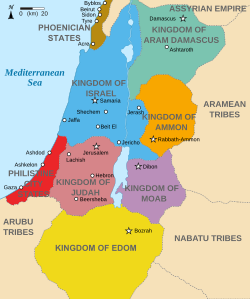
Back مملكة إدوم Arabic مملكة ادوم ARZ İdumeya Azerbaijani Ідумея Byelorussian Идумея Bulgarian ইদোম Bengali/Bangla Edom Breton Edom Catalan ئەدۆمیەکان CKB Edóm Czech
Kingdom of Edom 𐤀𐤃𐤌 | |
|---|---|
| c. 13th century BC–c. 553 BC[1] | |
 A theoretical map of the region around 830 BC (Edom shown in yellow) | |
| Status | Monarchy |
| Capital | Bozrah |
| Common languages | Edomite |
| Religion | Canaanite religion |
| History | |
• Established | c. 13th century BC |
• Conquered by the Babylonian king Nabonidus | c. 553 BC[1] |
| Today part of | |
| History of Jordan |
|---|
 |
| Prehistory |
| Ancient history |
| Classical period |
| Islamic era |
| Emirate and mandate |
| Post-independence |
|
|
Edom (/ˈiːdəm/;[2][3] Edomite: 𐤀𐤃𐤌 ʾDM; Hebrew: אֱדוֹם ʾĔḏōm, lit.: "red"; Akkadian: 𒌑𒁺𒈪 Údumi, 𒌑𒁺𒈬 Údumu;[4] Ancient Egyptian: jdwmꜥ)[5] was an ancient kingdom in Transjordan, located between Moab to the northeast, the Arabah to the west, and the Arabian Desert to the south and east.[6] Most of its former territory is now divided between present-day southern Jordan and Israel. Edom appears in written sources relating to the late Bronze Age and to the Iron Age in the Levant.
Edomites are related in several ancient sources including the list of the Egyptian pharaoh Seti I from c. 1215 BC as well as in the chronicle of a campaign by Ramesses III (r. 1186–1155 BC), and the Tanakh.[6] Archaeological investigation has shown that the nation flourished between the 13th and the 8th centuries BC and was destroyed after a period of decline in the 6th century BC by the Babylonians.[6] After the fall of the kingdom of Edom, the Edomites were pushed westward towards southern Judah by nomadic tribes coming from the east; among them were the Arab Nabataeans, who first appeared in the historical annals of the 4th century BC and had already established their own kingdom in what used to be Edom by the first half of the 2nd century BC.[6] More recent excavations show that the process of Edomite settlement in the southern parts of the Kingdom of Judah and parts of the Negev down to Timna had started already before the destruction of the kingdom by Nebuchadnezzar II in 587/86 BC, both by peaceful penetration and by military means and taking advantage of the already-weakened state of Judah.[7][8]
Once pushed out of their territory, the Edomites settled during the Persian period in an area comprising the southern hills of Judea down to the area north of Be'er Sheva.[9][10] The people appear under a Greek form of their old name, as Idumeans or Idumaeans, and their new territory was called Idumea or Idumaea (Greek: Ἰδουμαία, Idoumaía; Latin: Idūmaea), a term that was used in the Hellenistic and Roman periods, also mentioned in the New Testament.[11][12] During the 2nd century BC, the Edomites were forcibly converted to Judaism by the Hasmoneans, and were incorporated into the Jewish population.[13] Other scholars believe that the assimilation was voluntary. [14]
Edom and Idumea are two related but distinct terms; they relate to a historically-contiguous population but to two separate, if adjacent, territories which the Edomites/Idumeans occupied in different periods of their history. The Edomites first established a kingdom ("Edom") in the southern area of modern-day Jordan and later migrated into the southern parts of the Kingdom of Judah ("Idumea", modern-day Mount Hebron)[dubious ] when Judah was first weakened and then destroyed by the Babylonians in the 6th century BC.[15][16]
- ^ Levin, Yigal (2015). "The Formation of Idumean Identity". Aram. 27. London: 187–202.
- ^ "Edom". Random House Webster's Unabridged Dictionary.
- ^ churchofjesuschrist.org: "Book of Mormon Pronunciation Guide" (retrieved 2012-02-25), IPA-ified from «ē´dum»
- ^ Parpola, Simo (1970). Neo-Assyrian Toponyms. Kevaeler: Butzon & Bercker. pp. 364–365.
- ^ Cite error: The named reference
Gauthierwas invoked but never defined (see the help page). - ^ a b c d Negev & Gibson (ed.), 2001, Edom; Edomites, pp. 149–150
- ^ Prof. Itzhaq Beit-Arieh (December 1996). "Edomites Advance into Judah". Biblical Archaeology Review. Retrieved 8 December 2015.
- ^ Jan Gunneweg; Th. Beier; U. Diehl; D. Lambrecht; H. Mommsen (August 1991). "'Edomite', 'Negbite'and 'Midianite' pottery from the Negev desert and Jordan: instrumental neutron activation analysis results". Archaeometry. 33 (2). Oxford, UK: Oxford University: 239–253. doi:10.1111/j.1475-4754.1991.tb00701.x. Retrieved 8 December 2015.
- ^ Negev & Gibson (ed.), 2001, Idumea, pp. 239–240
- ^ Ben-Yosef (1979), p. 25
- ^ Charles Léon Souvay, ed. (1910). "Idumea". Catholic Encyclopedia. New York: Robert Appleton Company. Retrieved 8 December 2015.
- ^ "Edom". Encyclopædia Britannica. Retrieved 8 December 2015.
- ^ Levin, Yigal (2020-09-24). "The Religion of Idumea and Its Relationship to Early Judaism". Religions. 11 (10): 487. doi:10.3390/rel11100487. ISSN 2077-1444.
- ^ Levin, Yigal (2020-09-24). "The Religion of Idumea and Its Relationship to Early Judaism". Religions. 11 (10): 487. doi:10.3390/rel11100487. ISSN 2077-1444.
- ^ Lepinski, Nadav (n.d.). "Tell Maresha". In Ben-Yosef, Sefi (ed.). Israel Guide - Judaea (A useful encyclopedia for the knowledge of the country) (in Hebrew). Vol. 9. Jerusalem: Keter Publishing House, in affiliation with the Israel Ministry of Defence. p. 325. OCLC 745203905.
- ^ Eph'al, Israel (1998). "Changes in Palestine during the Persian Period in Light of Epigraphic Sources". Israel Exploration Journal. 48 (1/2): 115. JSTOR 27926503.
© MMXXIII Rich X Search. We shall prevail. All rights reserved. Rich X Search